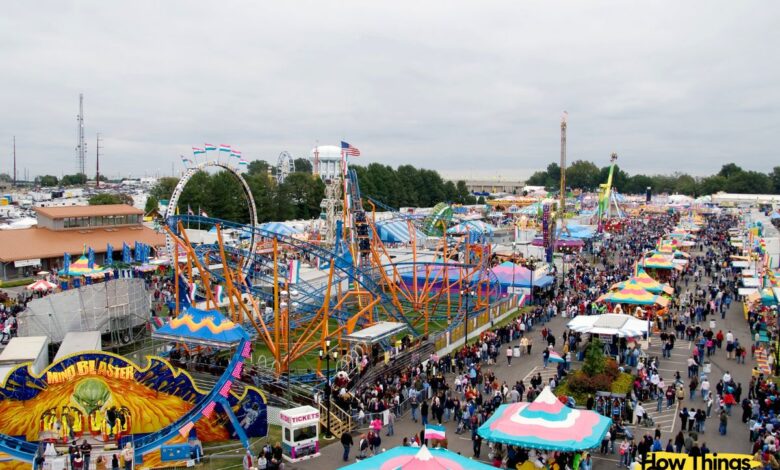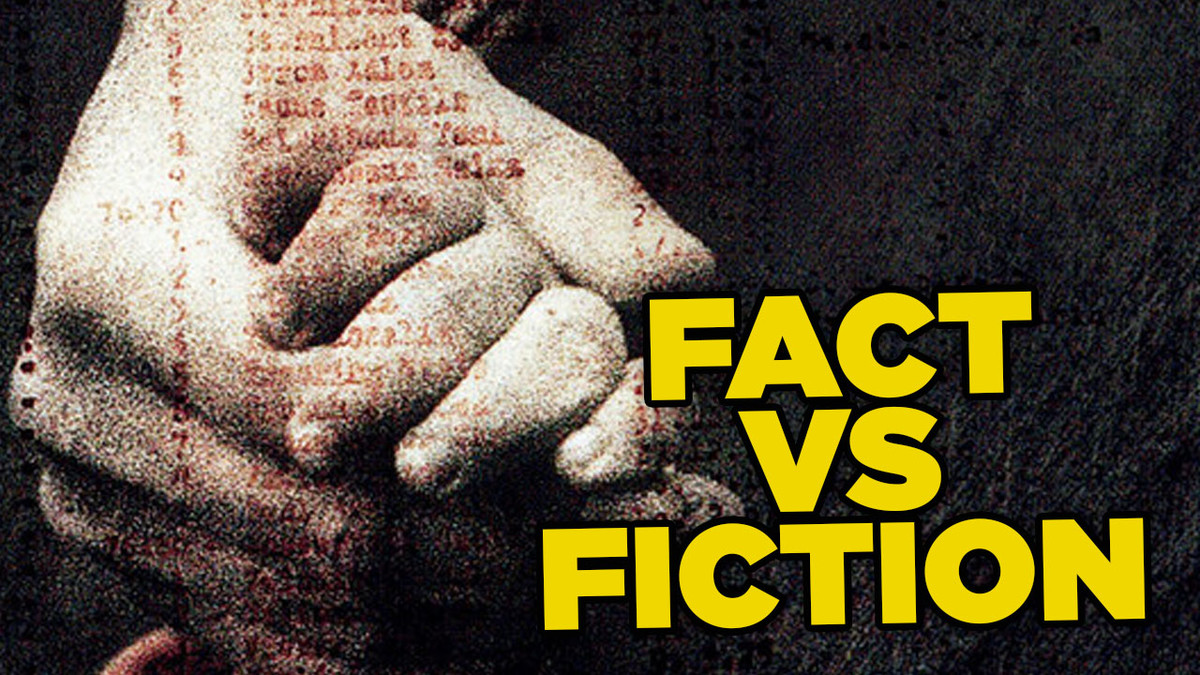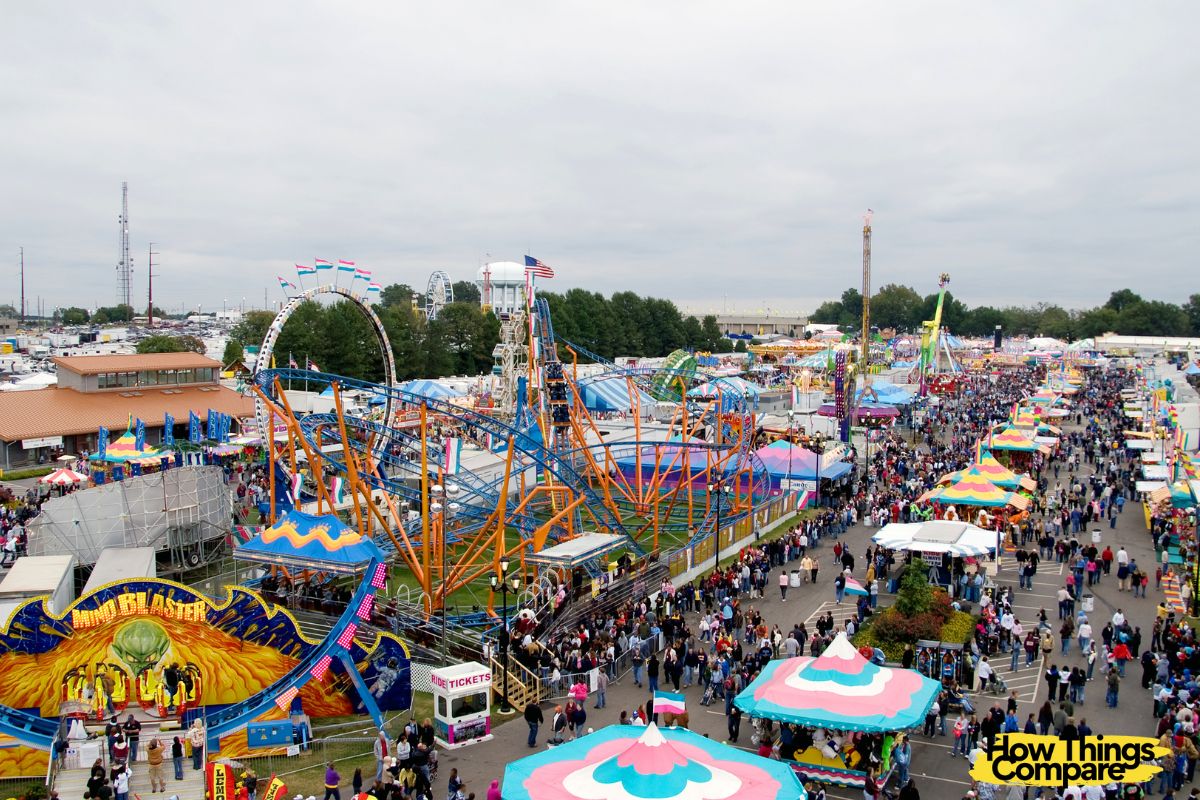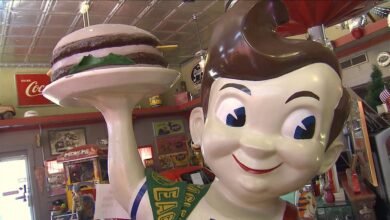
Carnival Fact vs Fiction Unveiling the Truth
Carnival fact vs fiction: A whirlwind of vibrant colors, lively music, and mouth-watering treats often shrouds the true historical context. This exploration delves into the fascinating world of carnivals, separating the factual from the fanciful. We’ll uncover the origins, customs, and even the myths surrounding these beloved celebrations, leaving you with a clearer understanding of their rich tapestry.
From the vibrant parades to the delectable delicacies, carnivals are a captivating blend of tradition and innovation. This post aims to shed light on the often-misunderstood aspects of these cultural events, ensuring you have a comprehensive view of the reality behind the revelry.
Carnival Origins and Evolution

Carnivals, vibrant celebrations of revelry and merriment, have captivated cultures across the globe for centuries. These festivities, often characterized by parades, costumes, and feasting, have evolved from humble beginnings to the diverse expressions we see today. Their historical roots lie in ancient traditions, and their evolution reflects changing societal values and cultural interactions. From the Roman Saturnalia to the modern-day Rio Carnival, the story of carnivals is one of adaptation and transformation.Understanding the origins and evolution of carnivals reveals a rich tapestry of cultural significance and historical context.
These celebrations are not merely about entertainment; they are deeply rooted in social, religious, and political traditions, often serving as a release from everyday routines and a celebration of life’s abundance. Exploring their various forms and adaptations offers insights into the human spirit’s enduring need for joyful expression and communal celebration.
Historical Overview of Carnivals
Carnivals have ancient roots, predating many modern religious and secular celebrations. Early forms were often associated with agricultural cycles and the winter solstice, embodying a transition from one season to the next. These celebrations frequently included elements of feasting, masquerades, and public displays of revelry. The Roman Saturnalia, a period of social inversion, served as a prototype for many later carnival traditions, with its emphasis on temporary freedom from societal norms.
Types of Carnivals
Carnival celebrations vary widely in form and character across different regions and cultures. Some are primarily religious in nature, while others are more secular, focusing on community and entertainment. Carnival celebrations in South America, like the Rio Carnival, are famous for their elaborate costumes, floats, and samba performances. In contrast, the Venetian Carnival is renowned for its masked balls and artistic expressions.
The historical context of each region heavily influences the specific characteristics of its carnival.
Evolution of Carnival Traditions
Carnival traditions have evolved significantly over time, adapting to changing social structures and cultural influences. Early carnivals often included elements of religious festivals, gradually evolving into secular celebrations as societies changed. The introduction of new technologies and social movements has also shaped carnival traditions, influencing the styles of costumes, the themes of celebrations, and the overall atmosphere.
Carnival facts can be surprisingly misleading, right? While some traditions are deeply rooted in history, others are just colorful myths. This is especially true when you consider the richness of Black history in travel, like the exciting new AmaWaterways first Black heritage cruise. This innovative journey shows us how much more there is to uncover about the past and how to appreciate the present.
The truth is, carnival’s past is a complex tapestry, woven with both the genuine and the fabricated.
Carnival Origins in Different Countries
| Country | Origins | Characteristics |
|---|---|---|
| Italy (Venice) | Rooted in ancient Roman celebrations, with influences from medieval traditions. | Known for masked balls, elaborate costumes, and a focus on artistic expression. The focus is on the temporary suspension of social norms and the celebration of artistic creativity. |
| Brazil (Rio) | Derived from Portuguese colonial traditions, incorporating elements of African and indigenous celebrations. | Characterized by extravagant parades, samba performances, and elaborate costumes. The cultural exchange between different communities is a significant aspect of the celebration. |
| Trinidad and Tobago | Developed through a mix of African, European, and indigenous traditions, significantly shaped by the transatlantic slave trade. | Famous for its vibrant steel pan music, masquerades, and elaborate costumes. The celebration reflects the rich cultural heritage of the region and its diverse population. |
This table summarizes the historical context and key characteristics of carnivals in three distinct countries, highlighting the unique blends of traditions that shaped their evolution.
Carnival Customs and Rituals
Carnival, a vibrant celebration of revelry and liberation, is deeply rooted in a rich tapestry of customs and rituals. These traditions, often imbued with symbolic meaning, vary across cultures but share a common thread of community engagement and a joyful embrace of the pre-Lenten season. The colorful parades, elaborate costumes, and unique culinary offerings are more than just entertainment; they represent a complex interplay of social, religious, and cultural forces.Traditional carnival customs, like parades, costumes, and food, hold significant symbolic meaning.
Debunking carnival myths is tricky! It’s easy to get caught up in the hype, but the reality is often more grounded in the Caribbean’s booming tourism sector. Increased airlift and cruise ship arrivals, as seen in this recent report on airlift and cruise ships help fuel caribbean growth , are a major factor in the island’s economy.
So, while the glitz and glamour are real, the underlying economic forces are just as important to understanding the carnival experience itself.
Parades, for instance, often represent a temporary inversion of social hierarchies, with participants expressing themselves freely and joyfully. Costumes serve as a powerful medium for self-expression and cultural commentary, while food, with its unique recipes and flavors, is a tangible representation of cultural heritage and shared community identity.
Symbolic Meanings of Carnival Customs
Carnival parades, frequently accompanied by music and dance, are more than just processions; they represent a temporary suspension of societal norms and a celebration of community. The costumes worn in these parades are often highly elaborate and colorful, allowing participants to embody different identities, characters, or even satirical social commentaries. This symbolic inversion, a common feature in many carnival celebrations, allows participants to express themselves beyond the constraints of everyday life.
Role of Masquerades and Costumes
Masquerades and costumes play a pivotal role in carnival celebrations. They offer a platform for self-expression, allowing participants to embrace different identities and challenge social norms. Elaborate costumes, often adorned with intricate designs and symbolic imagery, are not merely garments; they are statements reflecting cultural heritage, social commentary, or personal creativity.
Significance of Carnival Foods and Drinks
Carnival food and drinks are integral to the celebration. In many cultures, specific dishes and beverages are associated with the festivities. These foods and drinks often represent a temporary break from the usual diet and a celebration of culinary traditions. For example, in some parts of Latin America, a variety of pastries and sweets are enjoyed, while in other cultures, specific meats or local beverages are emphasized.
List of Five Common Carnival Rituals
Carnival celebrations are rich in rituals, many with deeply embedded cultural significance. These rituals often combine elements of fun, tradition, and a sense of community.
- Parades and processions: These are common features in various carnival celebrations, symbolizing the inversion of social order and community unity.
- Costuming and masking: The act of donning costumes and masks allows individuals to embody different characters, express themselves freely, and engage in symbolic commentary on society.
- Food and drink rituals: Unique culinary offerings, often representing cultural heritage and a temporary break from daily routines, are essential parts of many carnivals.
- Inversion of social roles: A key element of many carnival celebrations, the temporary inversion of social hierarchies allows for a release of inhibitions and a celebration of equality.
- Public celebration and communal spirit: Carnival festivities emphasize a sense of community, bringing people together in joyous celebration and fostering a shared experience.
Diverse Costumes Worn in Carnival Celebrations
The costumes worn in different carnival celebrations reflect the unique cultural heritage and traditions of each region. These costumes often feature elaborate designs, vibrant colors, and symbolic imagery.
| Carnival Celebration | Typical Costume Features |
|---|---|
| Brazilian Carnival | Elaborate costumes, often incorporating feathers, sequins, and vibrant colors. Themes may include mythological creatures or historical figures. |
| Venetian Carnival | Elaborate masks, often with intricate designs and symbolic meanings. Costumes may range from formal attire to more whimsical designs. |
| Mardi Gras (New Orleans) | Colorful costumes, often reflecting the unique culture of New Orleans. The “krewes” or groups participating often have specific themes. |
| Rio Carnival | Elaborate costumes, often with detailed designs and intricate embellishments. Themes may include historical figures, mythological characters, or social commentaries. |
| Trinidad Carnival | Vibrant costumes, often incorporating elaborate designs and vibrant colors. The costumes frequently showcase local artistic talent and creativity. |
Carnival Food and Drink
Carnival celebrations are vibrant spectacles, and food and drink play a significant role in their atmosphere. From the unique flavors to the elaborate preparations, culinary traditions often reflect the history, culture, and social dynamics of the region. These treats aren’t just sustenance; they’re an integral part of the carnival experience, representing community, tradition, and the joyous spirit of the event.Carnival food and drink are often a reflection of local ingredients and historical influences.
These culinary traditions can be traced back to centuries-old customs and practices, providing a fascinating glimpse into the evolution of the celebrations. The availability of certain ingredients, the cooking methods used, and the presentation of dishes can all contribute to the unique flavor profiles and aesthetic appeal of carnival treats.
Common Carnival Foods and Drinks Globally
Carnival celebrations worldwide feature a diverse range of food and drink options. From sweet pastries to savory meats, the choices reflect the regional availability of ingredients and local preferences. Many of these dishes have been passed down through generations, preserving cultural heritage and culinary traditions.
Ever wondered about the truth behind carnival myths? It’s fascinating how many stories get twisted! Speaking of intriguing journeys, did you know that AMA Waterways is launching a 10th anniversary agent contest ? It’s a great opportunity for travel agents to showcase their expertise. But back to carnival facts – let’s dive deeper into the real stories behind the legends!
Historical and Cultural Significance of Specific Carnival Foods
Many carnival foods hold deep historical and cultural significance. In some cultures, certain dishes are associated with specific rituals or beliefs, while in others, they represent a celebration of abundance and prosperity. For instance, the use of specific ingredients in carnival foods might be linked to historical events or seasonal availability.
Culinary Traditions of Two Distinct Carnivals
Carnival celebrations in Rio de Janeiro, Brazil, and Venice, Italy, offer distinct culinary experiences. The Brazilian Carnival often features vibrant street food like “pastel” (savory pastries filled with various ingredients), “acarajé” (deep-fried bean fritters), and “cocada” (coconut candy). In contrast, Venetian Carnival traditions focus on rich pastries like “frittelle” (fried doughnuts) and “pandoro” (sweet bread), often infused with local flavors.
Unique Carnival Foods from Different Regions
| Region | Food | Recipe (brief) |
|---|---|---|
| Brazil (Rio de Janeiro) | Acarajé | Deep-fried fritters made from black-eyed peas, seasoned with palm oil and spices. Often served with a side of vatapá (a creamy, spicy stew). |
| Mexico (various carnivals) | Elote | Grilled corn on the cob, topped with mayonnaise, cotija cheese, chili powder, and lime juice. |
| Venice, Italy | Frittelle | Deep-fried dough balls, often filled with custard or other sweet fillings, dusted with powdered sugar. |
| New Orleans, USA (Mardi Gras) | King Cake | Sweet pastry, typically ring-shaped, with a small plastic baby hidden inside. Made with a brioche-like dough and often topped with icing. |
| Trinidad and Tobago (Carnival) | Doubles | Two halves of a split bread roll filled with curried chickpeas, potatoes, and spices. |
Carnival Music and Entertainment
Carnival celebrations are not just about costumes and parades; they are vibrant spectacles fueled by infectious music and captivating entertainment. The rhythm and melodies of carnival music create a unique atmosphere, drawing participants into the revelry and fostering a sense of shared joy. Music and entertainment play a pivotal role in shaping the carnival experience, from the lively beats of street bands to the captivating performances that grace the stages.The role of music in carnival goes far beyond simple accompaniment.
It acts as a powerful catalyst, igniting enthusiasm, and driving the energy of the festivities. Music sets the tempo for dancing, drumming, and singing, unifying participants in a shared experience of celebration. From the rhythmic beats of percussion instruments to the soaring melodies of brass bands, the sound of carnival music is a defining characteristic of these vibrant cultural events.
Types of Music Associated with Carnival Celebrations
Carnival music encompasses a wide range of styles, reflecting the diverse cultural influences present in different regions. From the lively rhythms of Caribbean calypso and soca to the infectious beats of Brazilian samba, and the vibrant tunes of Latin American cumbia, the soundscapes of carnival celebrations are incredibly varied. Traditional folk music often plays a significant role, incorporating local instruments and melodies that add to the unique character of each celebration.
Ever wondered about the truth behind carnival myths? It’s fascinating how many stories get spun around these events! While some carnival facts are surprisingly true, many are just pure fiction. For a different kind of thrill, check out the awesome anthem a good sport with skydiving simulator experience, where you can feel the rush without the crowds.
But back to carnivals, it’s all about the fun and the mystery! Separating fact from fiction is part of the enjoyment.
Role of Music and Entertainment in Creating the Carnival Atmosphere
Carnival music and entertainment are not merely background noise; they are integral components of the atmosphere, shaping the overall experience. The energetic performances, whether from street bands or stage shows, create a palpable sense of excitement and festivity. The music’s rhythms and melodies are designed to encourage participation and movement, fostering a collective feeling of joy and belonging.
The vibrant visual displays, coupled with the powerful sound of the music, create a unique and unforgettable atmosphere.
Examples of Famous Carnival Musicians and Bands
Numerous musicians and bands have left an indelible mark on the world of carnival music. For example, the renowned steel drum bands of Trinidad and Tobago, such as the parang bands of the Philippines, are celebrated for their unique sounds and intricate performances. The rhythms of Brazilian samba schools, such as the iconic Rio de Janeiro Carnival, are renowned for their captivating energy and elaborate displays.
Comparison and Contrast of Music Styles of Two Different Carnivals
Carnival music styles vary considerably between different celebrations. For instance, the music of the Rio de Janeiro Carnival is often characterized by its samba rhythms, with a strong emphasis on brass instruments and percussion. In contrast, the music of the Notting Hill Carnival in London features a blend of calypso, reggae, and soca rhythms, accompanied by a wider variety of instruments, including steel drums.
The different styles reflect the distinct cultural heritage of the celebrations.
Carnival Music Instruments
Carnival parades often feature a diverse array of instruments, creating a unique sonic tapestry. These instruments reflect the cultural traditions of the region, and their distinct sounds contribute to the overall atmosphere of the event.
| Instrument | Region/Carnival | Description |
|---|---|---|
| Steel Drums | Trinidad and Tobago | A distinctive instrument made from oil drums, used to create a wide range of rhythmic sounds. |
| Congas | Latin America | A type of drum, played with a rhythmic style that is common in many carnival parades. |
| Panpipes | South America | A wind instrument, played in a traditional style, often with melodies that are characteristic of a region. |
| Clarinets | Various | A woodwind instrument, used in many carnival parades to create melodies and rhythmic patterns. |
| Trumpets | Various | A brass instrument, often used in brass bands to produce powerful sounds. |
Carnival Celebrations and Traditions
Carnival, a vibrant celebration of life, community, and often, liberation, takes many forms around the world. From the elaborate parades of Rio de Janeiro to the intimate street parties of Trinidad and Tobago, carnival traditions reflect the unique cultures and histories of the communities that embrace them. This diverse expression of festivity underscores the importance of carnival as a powerful tool for social interaction and cultural preservation.Carnival celebrations are not simply about revelry; they are deeply embedded in the social fabric of participating communities.
These celebrations provide opportunities for people to come together, share in common experiences, and reinforce a sense of belonging. The traditions, costumes, and music contribute to a unique atmosphere, shaping the very spirit of the event. The depth of community participation is vital in maintaining the vibrant character and historical significance of carnival.
Community Participation in Carnival, Carnival fact vs fiction
Carnival is not a spectator sport; it is a participatory event. Communities actively engage in every aspect of the celebration, from creating costumes and music to organizing events and parades. This active participation is crucial in maintaining the authenticity and cultural significance of the event. Volunteers and local groups play vital roles in organizing and executing the many elements of the celebration.
Unique Carnival Celebrations Around the World
Different cultures celebrate carnival with unique expressions. The exuberance and grandeur of Rio’s parades contrast sharply with the more intimate street parties of Trinidad, reflecting the diverse social and historical contexts of these communities. The cultural heritage of each community is deeply interwoven into the celebrations. Each celebration, from the flamboyant pageantry to the intimate neighborhood gatherings, carries its own distinct flavour, reflecting the unique identity of the community.
Role of Community Participation in Maintaining Traditions
The active involvement of communities is paramount in sustaining carnival traditions. When individuals contribute their time, resources, and creativity, they actively safeguard the cultural heritage that carnival represents. The collective effort ensures that these traditions are passed down through generations, maintaining their authenticity and relevance. This communal commitment creates a living testament to the resilience and creativity of the culture.
Comparison of Participation Levels Across Demographics
Carnival celebrations, while inclusive, can sometimes present varying levels of participation across different demographics. Factors like socioeconomic status, cultural background, and access to resources can influence involvement. However, in many communities, carnival serves as a powerful unifying force, bringing people together regardless of background. Efforts to promote inclusive participation and ensure that all segments of the community feel welcome and valued can help ensure a more equitable celebration.
Table of Five Different Carnival Celebrations
| Carnival Celebration | Country/Region | Unique Traditions |
|---|---|---|
| Rio Carnival | Brazil | Elaborate floats, elaborate costumes, Samba schools, parades |
| Trinidad Carnival | Trinidad and Tobago | Calypso music, steel pan bands, elaborate costumes, street parties |
| Venice Carnival | Italy | Elaborate masks, masquerade balls, street parades, historical costumes |
| Mardi Gras | Various U.S. cities | Parades, balls, costumes, public celebrations, feasting |
| Quebec Carnival | Canada | Parades, ice sculptures, snow festivities, local cuisine |
Carnival Myths and Legends
Carnival, a vibrant celebration of revelry and merriment, is often shrouded in a tapestry of myths and legends. These stories, passed down through generations, offer a glimpse into the cultural and historical context surrounding these festivals. They also illuminate how these celebrations have shaped the very perception of carnivals, influencing everything from costumes to rituals.Carnival’s myths and legends are more than just fanciful tales; they are reflections of societal values, anxieties, and hopes.
These stories evolved over time, adapting to the changing cultural landscape. They frequently incorporate elements of folklore, religious beliefs, and historical events. Examining these myths provides valuable insight into the spirit of carnival and its enduring appeal.
Popular Carnival Myths and Legends
These stories often intertwine with the history of the carnival itself, reflecting the social and cultural dynamics of the time. Understanding their origins provides a richer appreciation for the celebrations. These stories provide a fascinating look at how people have interpreted and reacted to these vibrant festivities.
Carnival’s got a lot of fun myths, doesn’t it? Like, are those elaborate floats truly built overnight? It’s fascinating how a seemingly simple celebration can have so many layers of truth and fiction. This reminds me of the intriguing back story to a remarriage, back story to a remarriage , where the couple’s history intertwines with their present, creating a unique narrative that’s far from the typical fairy tale.
Ultimately, carnival’s charm lies in the blend of its imagined and real stories, just like life itself.
Five Carnival Myths and Legends
Carnival folklore is rich with captivating stories. These narratives, while often embellished, offer insights into the historical context and cultural significance of the festivities.
- The Myth of the Carnival King/Queen: In many carnivals, the figure of a King or Queen emerges, often with extravagant costumes and symbolic power. The origins of this tradition are multifaceted. Sometimes it’s a representation of the temporary inversion of social hierarchy, a moment to challenge societal norms. Other times, the figure is tied to a local patron saint or historical figure, connecting the carnival to the community’s past.
This figure embodies the spirit of the carnival, embodying the festive spirit.
- The Legend of the Masked Reveler: The use of masks in carnivals often conceals identities, allowing participants to shed their everyday roles and embrace a new persona. This practice can be traced back to the desire to challenge social norms or to hide one’s true self for a time. In some communities, the mask served as a protective shield, enabling individuals to engage in playful banter or confrontational behaviors without fear of reprisal.
The masked reveler is a common symbol of liberation and playfulness.
- The Origin of Carnival Food Traditions: Many carnival dishes have intriguing legends behind them. The origins of certain foods may be linked to local agricultural practices or historical events. For instance, a specific type of cake might have been associated with a harvest festival, or a particular dish might have been a way to commemorate a significant historical figure. The connection between food and tradition is undeniable, as these dishes serve as a connection to the past.
- The Carnival and the Supernatural: In some cultures, carnivals are linked to the supernatural world. This might manifest in legends about spirits or supernatural beings who participate in the festivities. These beliefs often reflect the anxieties and fears of the time, but they also serve to emphasize the liminal nature of the celebration, a time when the boundaries between the worlds become blurred.
This supernatural connection adds a layer of mystery and intrigue.
- Carnival and the Inversion of Social Order: A common thread in carnival legends is the temporary inversion of social hierarchies. This might involve the lower classes mocking the upper classes, or the traditionally powerful relinquishing their authority for a time. This inversion reflects a societal desire to momentarily challenge the status quo, allowing for a release of tension and a celebration of community.
Comparing Carnival Myths and Legends
Comparing the myths and legends associated with different carnivals reveals interesting similarities and differences. Carnival celebrations in different regions reflect distinct cultural contexts and historical experiences. For example, a carnival in a predominantly agricultural region might have myths centered around harvest and fertility, while a carnival in a port city might incorporate seafaring legends.
Carnival Fact vs. Fiction
Carnival, a vibrant tapestry of tradition and celebration, is often shrouded in myths and legends. From the origins of its costumes to the accuracy of its historical events, there are many claims that are either completely fabricated or have been embellished over time. This exploration dives into specific examples, separating fact from fiction to provide a clearer understanding of this captivating cultural phenomenon.Carnival’s rich history is intertwined with evolving social and cultural contexts, leading to the development of unique traditions and customs.
However, some narratives about these traditions have become distorted over time, transforming into folklore and misconceptions. This analysis aims to clarify these inaccuracies and highlight the true historical context of carnival celebrations.
Specific Claims About Carnival Traditions and Customs
Carnival traditions, like elaborate costumes and elaborate parades, have evolved over time. Some accounts exaggerate the origins or significance of certain customs, often attributing them to specific historical figures or events that are not completely accurate. Examining these claims helps us understand the historical development of carnival practices and the ways they’ve been reinterpreted.
- The “Masked Ball” Myth: Many carnival celebrations feature masked figures, which are often perceived as a symbol of anonymity and liberation. Some accounts claim that masked balls originated from specific historical events or were integral to early carnival celebrations. However, the emergence of masked balls is more nuanced. In many instances, the practice of masking likely evolved gradually, influenced by various factors like social norms, religious practices, and theatrical traditions.
- Exaggerated Descriptions of Early Carnival Revelry: Some historical accounts of early carnival celebrations depict unrestrained revelry and excessive behaviors. While there was undoubtedly a festive spirit, accounts often emphasize the negative aspects to a degree that may not be accurate. Detailed historical analysis reveals that the level of disorder was likely more context-dependent, varying by location and time period.
Historical Accuracy of Claims
The accuracy of claims regarding carnival history can be difficult to determine. Comparing different historical accounts and primary sources is crucial to establish a more complete picture.
| Claim | Historical Accuracy | Supporting Evidence |
|---|---|---|
| Carnival originated in ancient Rome. | Partially accurate. | While Roman festivals may have shared some similarities, carnival’s specific customs and traditions evolved separately from Roman celebrations. |
| Carnival celebrations were always characterized by extreme debauchery. | Inaccurate. | While excessive behavior occurred in some instances, it wasn’t a universal characteristic across all carnival celebrations or throughout history. |
Origins of Carnival Myths and Legends
Many carnival myths and legends are rooted in folklore and oral traditions. These stories often serve to explain the origins of customs or rituals or embellish their significance. Analyzing the origins of these stories can reveal insights into the cultural values and beliefs of the communities that developed them.
- The Legend of the Carnival King: The idea of a Carnival King, a figure associated with the revelry and festivities, may stem from earlier figures of authority, but often has been developed into a myth. The role of the king might have evolved from social hierarchies or political representations.
- Origins of Carnival Costumes: The extravagant costumes associated with carnival may have evolved from a combination of historical costuming traditions, religious practices, and social performances. These costumes were not always meant to symbolize a single, unifying idea.
Common Misconceptions About Carnivals
Some common misconceptions about carnivals stem from simplified or generalized interpretations of historical events or cultural practices. Understanding these misconceptions helps to appreciate the complexity and diversity of carnival traditions.
- Carnivals as Primarily About Excess: While carnivals often involve festivities and celebrations, the core of the tradition is much more multifaceted. Carnivals are about social interaction, community building, and artistic expression, in addition to the element of revelry. It is inaccurate to view carnivals solely through the lens of excess.
Sources for Researching Carnival Facts and Fictions
Academic journals, historical archives, and cultural studies literature are important sources for researching carnival facts and fictions. These sources provide a deeper understanding of the historical context and cultural significance of carnivals.
- Primary Sources: Documents from the time period in question, like diaries, letters, and official records, provide direct insight into the practices and beliefs of those who participated in carnival celebrations.
- Secondary Sources: Scholarly articles, books, and documentaries offer analysis and interpretation of primary sources, often providing a broader context for understanding carnival history.
Outcome Summary

In conclusion, carnival fact vs fiction reveals a captivating journey through history and culture. While some myths and legends have taken root, the true essence of carnivals lies in their vibrant traditions, community participation, and the unique cultural expressions they embody. Hopefully, this exploration has not only debunked some common misconceptions but also ignited your curiosity to delve deeper into the world of carnivals around the globe.
Answers to Common Questions: Carnival Fact Vs Fiction
What are some common misconceptions about carnival food?
Many believe specific carnival foods are unique to a particular region. In reality, some dishes may have similar variations across different carnivals, reflecting the global spread of culinary ideas. The unique recipes are often based on local ingredients and preferences.
How have carnival celebrations adapted to modern times?
Modern carnivals often incorporate contemporary elements into traditional celebrations, such as incorporating technology in parade routes or marketing strategies. This balance of old and new helps ensure the continuation of these cultural events.
What role does music play in the overall carnival experience?
Music is crucial in setting the lively atmosphere and energy of a carnival. The type of music can vary considerably based on the specific carnival and its cultural origins, but its role in bringing people together is consistent across cultures.
Why do some carnivals feature elaborate costumes?
Costumes often symbolize a specific theme or cultural identity. These elaborate costumes, in addition to music and parades, create a unique spectacle, contributing to the carnival’s overall excitement and atmosphere.






